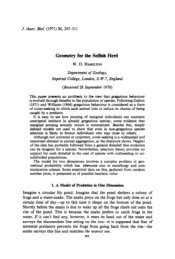Jenis Crinoid Feather Stars
Jenis Crinoid Feather Stars
Jenis Crinoid Feather Stars
Create successful ePaper yourself
Turn your PDF publications into a flip-book with our unique Google optimized e-Paper software.
o So each arm is a series of ossicles extending outward from the body.<br />
• The arms contain extensions of coelomic (body cavity), nervous, water vascular,<br />
and reproductive systems<br />
• They also have an ambulacra (radial area) groove bordered by fingerlike tube<br />
feet, or podia, which are extensions of the water vascular system as well. They<br />
are also used in suspension feeding and respiration<br />
• All living crinoids are pinnulate, bearing a small side branch, pinnule, on<br />
alternating sides of successive ossicles along the arm. These pinnules bear the<br />
food-gathering tube feet.<br />
o Pinnules arose in several lineages during the Paleozoic and are<br />
characteristic of all post-Palaeozoic crinoids.<br />
• <strong>Crinoid</strong>s have muscles, nerves, a gut, a reproductive system and other features<br />
Feeding<br />
of advanced animals.<br />
• They are all passive suspension and filter feeders and because they produce no<br />
feeding or respiratory current, they rely more on the water movement around<br />
them, feeding by filtering small particles of food from those seawater currents.<br />
• Their diet consists of a variety of protists (i.e. diatoms and other unicellular algae,<br />
foraminiferans, actinopods), invertebrate larvae, small crustaceans, and detrital<br />
particles.<br />
• To feed they use their featherlike arms that radiates from the central body which<br />
each bears an open ambulacra groove bordered by triads od fingerlike podia
















